TRAVELS WITH YOUR NAVIGO – CHATEAU DE VERSAILLES
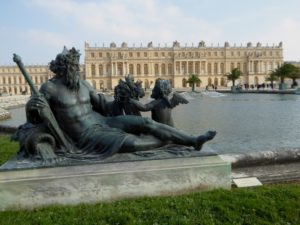
The history of Versailles is inextricably linked with Louis VIV, although there had been a residence there for centuries before he ascended the throne. As Dauphin, Louis XIV had loved to hunt in the forests surrounding the small chateau that his father Louis XIII had rebuilt from the original brick and stone hunting lodge. These works were ongoing until 1634, which laid the basis for the chateau we know today.
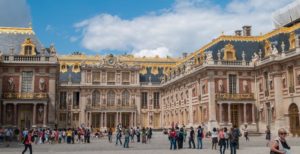
When Louis XIV inherited the estate, he undertook major building projects on the site starting in 1661 and continued until the end of his life in 1715. Versailles remained a royal residence until the French Revolution in 1789, and is now a classified Monument historique as well as being a UNESCO World Heritage site. Official figures show that the complex received more than 7,700,000 visitors in 2017, making it the second-most visited monument in the Ile-de-France, just behind the Louvre, but ahead of the Eiffel Tower.
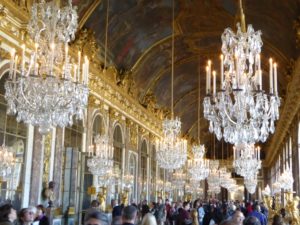
Anyone interested in Versailles will be familiar with its appearance and many famous features such as the dazzling 70 metre long Galerie des Glaces (Hall of Mirrors) through film, photos and travel articles.
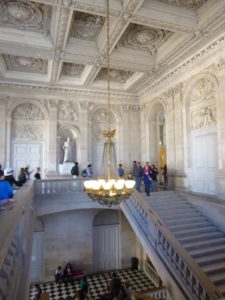
Even so, first time visitors are, not unsurprisingly, often overwhelmed when confronted by the sheer size of the chateau which encompasses 67,000 square metres with more than 700 rooms—some sources say there are 2,300 rooms—and 67 staircases!
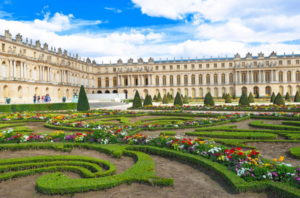
As well, there’s the vast estate of ornamental gardens, groves of trees and grottoes, 50 fountains, 620 water jets, pools and canals, plus the smaller royal residences, the Grand Trianon, Petit Trianon and the small Hameau, Marie Antoinette’s faux-rustic fantasy covering more than 800 hectares.
In the past, its daunting size has been a barrier for many visitors to hope to explore the furthest reaches of the estate in a day’s visit. A few years ago in response to issue, a number of self-drive golf carts were made available for visitors to rent on an hourly basis.
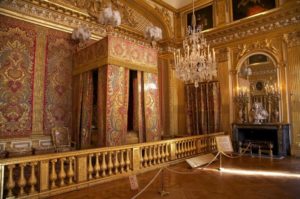
With so much splendour to see, it’s no small feat to decide what’s not to be missed. In the palace the obvious place to start a visit is the royal apartments, which include the appartement du roi and the petit appartement de la reine.
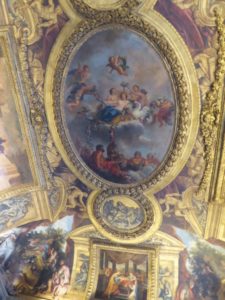
The king’s State Apartment consists of a suite of 7 exquisite rooms, each dedicated to one of the planets known at the time, and their associated Roman deity, such as the Salon of Hercules, the Salon of Venus, the Salon of Apollo etc. Under Louis XIV, these rooms were used as galleries for his finest paintings and venues for receptions and entertainments.
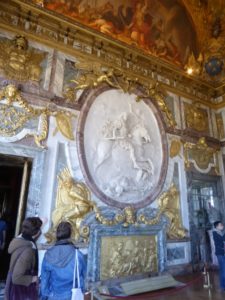
In the Salon of Mercury, look out for the Automaton Clock made for the king in 1706, which, when it chimes the hour, figures of Louis XIV and Fame descent from a cloud.
The Hall of Mirrors is adjacent to the King’s Apartments, and is one of three highly decorated reception spaces, the other two being the Peace Salon and the War Salon, both these adorned with appropriately themed paintings, frescoes and sculptures. During the reign of Louis XV, his Queen, Marie Leszczynska, used this room as a music room.
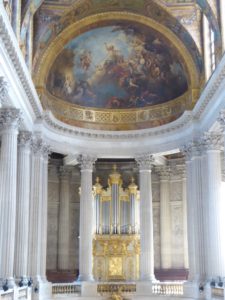
Other major attractions include the very beautiful Royal Chapel, which was used for weddings and baptisms until 1789, and the Royal Opera. This theatre was commissioned by Louis XIV in 1682 but the project was put aside, due to the vast expense of the king’s foreign wars. The Opera was finally inaugurated on 16 May 1770, as part of the celebrations of the wedding of Louis XVI and Marie Antoinette.
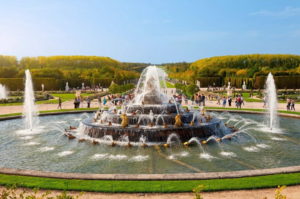
After so much opulence, and almost visual overload, it’s something of a relief to venture out of the chateau to visit the gardens and fountains. The nearest two are the Parterre d’Eau and the Parterre and Fountain of Latona, which are large pools designed to reflect the façade of the palace. The Latona Fountain contains sculptures illustrating the story of Latona, taken from Ovid’s ‘Metamorphoses’.
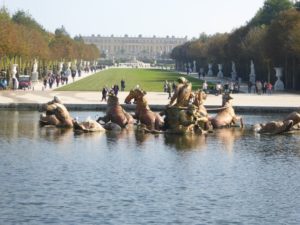
Further out is the Fountain of the Chariot of Apollo, with its dazzling gilded chariot rising from the water. Beyond this is the Grand Canal which extends 1,800 metres into the park.
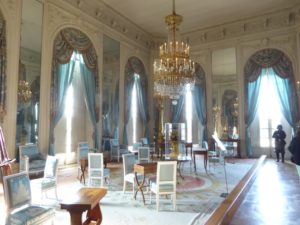
There are numerous other fountains and bosquets, or groves, to visit and of course the Trianons, which was the name of the village that adjoined the royal park. The village was purchased by Louis XIV as a place where he wished to construct an intimate, less formal residence for himself. There’s the Grand Trianon, designed in the Classical style, and the Neo-Classic Petit Trianon, with its exquisite Queen’s Theatre.
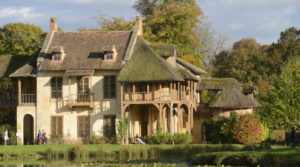
Not far from the Petit Trianon is the Hameau de la Reine, the Queen’s Hamlet, where Marie Antoinette and her friends played at being “peasants” with a dairy and a mill, and a luxuriously appointed farmhouse, complete with a billiard room.
There is no “off season” for Versailles, although of course high summer sees visitor numbers at their peak, but even so the winter months still attract hoards every day it’s open.
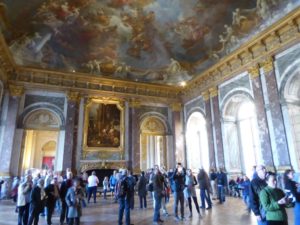
In high season—from April to late October—admission is charged for the gardens on Musical Fountains and Musical Gardens Show days, i.e., Tuesdays, Fridays, Saturdays and Sundays, as well as on some additional days during the year, such as French national holidays.
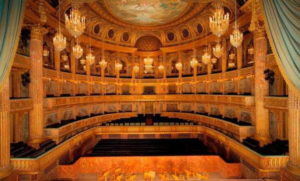
There are two options: a 1 or 2 day Passport ticket or a Passport ticket with a timed entry, which grant admission to the whole estate of Versailles. Otherwise, purchase a Musical Fountains Show or a Musical Gardens ticket to just visit the gardens. The best bet though is to buy a ticket for the entire estate, which will include the chateau itself, the Trianon estate, which comprises the Grand Trianon, Petit Trianon and the Queen’s Hamlet.
Getting to Versailles is very straightforward from Paris, so no need to take a tour. Rather than trailing along behind a guide, droning on about “how old, how high, how many rooms…” and countless portraits of royal personages described in minute detail, it’s much better to hire an audio guide to explore the parts of the chateau and park that interest you, at your own pace.
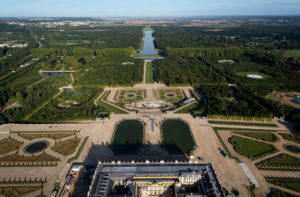
From Paris, your Navigo will take you out to Versailles. If you don’t have one, you will need to buy a return train ticket, and be aware that the regular white tickets you buy individually or with a carnet (collection of 10), don’t take you out as far as Versailles.
Note that Versailles is on the RER train network, not the metro. The RER is the outer suburban network, separate from the metro system, and as this is a much newer system than the metro, these lines are usually much deeper underground. The Chateau is about 20 kms. out of the city. Trains run about every 20 mins.
You want RER Line C, so you need to find a station that has RER lines as well as the metro lines. For example, if you were starting out from Austerlitz station, you will be travelling in the direction of St-Michel Notre Dame, Invalides etc., and at about Champs de Mars the line takes the fork to Versailles Rive Gauche/Chateau de Versailles. The first stop after the fork is Javel, then Pont du Garigliano, Issy and so on to the end of the line, which is your stop. So make sure you pay attention to the indicator board and get the train that takes the correct branch, otherwise, after Champs de Mars, the train will end up at Porte de Clichy.
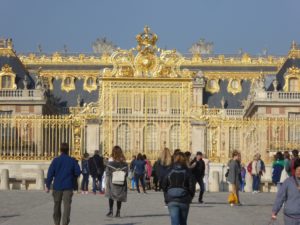
Once you arrive at the Versailles Rive Gauche/Chateau de Versailles station, the Chateau is only about 5 mins. walk. Exit the station, cross the street, turn right, then take a left into rue de Paris, which will lead you right to the front gates of the Chateau.
If you don’t already have an entry ticket, go the ticket office then head to Entrance A, which is for individuals, not groups. You can also buy a ticket online and print it off to take with you.
There is also a Tourist Office (Bureau de Tourisme) opposite the railway station at Versailles that sells tickets—perhaps a better bet than at the Chateau itself, although there will likely be just as long a queue here too!
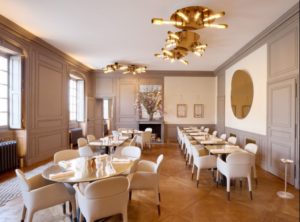
After a thoroughly enjoyable, but tiring visit to the chateau and grounds, before leaving head to Alain Ducasse’s latest restaurant, suitably called ‘Ore’, in homage of the lavish application of gilding everywhere. There’s a well-priced lunch menu, or later, treat yourself to a beautiful afternoon tea or light meal, served from 3.30pm-6.30pm. The incredible hot chocolate (from their own chocolaterie) sets the benchmark ever after for this drink—justification enough for the trip out the Versailles! Located towards the front exit, you might need to ask staff for directions, as it’s very discreet. Worth knowing is that ‘Ore’ patrons can purchase a ticket with direct access to the chateau for 20 Euros.
“It’s not a palace, it’s an entire city. Superb in its size, superb in its matter.” Charles Perrault, Le Siecle de Louis le Grand, 1687
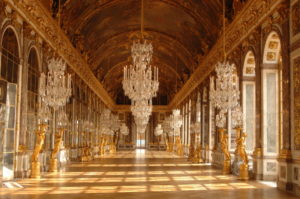


Great article and fantastic advice for getting to Versailles. My first trip there was on a tour bus from Paris. As we pulled up into the car parking area, we were told we had 1 hour and 10 minutes to be back on the bus! Therefore, saw very little. My second visit I got the RER and stayed in Versailles for 3 days! Such a beautiful, fascinating place. Thank you for bringing back wonderful memories.
Hi Kaye,
So glad you enjoyed the article. We once had an experience very similar to yours, when we visited a chateau in the Loire many years ago (can’t recall which one of the many we went to). We were confined to each room as the guide locked each door behind the group as we progressed at a snail’s pace through the vast chateau. As the room ahead was also locked, we were unable to make a discreet exit and had to wait until the end, as she droned on and on about each and every piece of furniture, objet d’art, portrait of obscure noblepersons…it was interminable! It was a lesson for life. Tours of chateaux or stately homes can be great if you know what you’re in for. However, there’s also nothing worse than being rushed through where you’ve little or no time to appreciate what you’re looking at in often enormous properties. A lot to be said for audioguides or a good reference book.